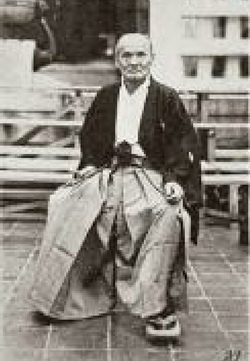

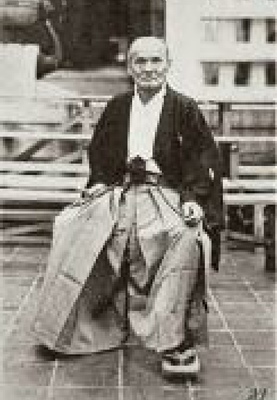
Inside Nihon Goshin Aikido ~ #27
June 5, 2015
In This Issue:
- Sho-Dan Testing ~ What You Need to Know
- Nage’s Work Station ~ Part 2
- “Do’s and Don’ts” When Growing the Art Via Dojo Multiplication
- Hokkaido 2020: My Proposal to Re-launch a Nihon Goshin Aikido Dojo in Chitose, on the Island of Hokkaido in Japan by 2020
- Growing Our Subscriber Base ~ Please Forward to your Friends and training buddies
- Announcements: Got a rank promotion, opening a new dojo, hosting a seminar, etc.
Greetings Nihon Goshin Aikido Aficionado!
Let it be summer! As always, I hope my efforts will be worth your time, and always feel free to comment without regard. We are interested in the exchange of ideas so add what you can to the conversation!
Before we get too much deeper, keep in mind that I’m just a guy writing stuff down. Nothing I say should be taken as gospel, and certainly nothing I say should ever be assumed to be offered as an “official Nihon Goshin Aikido position.” I learn by writing things down. I write a lot because I hope to learn a lot. Alright, well with the disclaimer out of the way, let’s look at what’s ahead in this issue.
1. The Sho-Dan Test.
Here are some concepts that may help the student getting ready for their sho-dan test.
Proper Mindset Toward Your Future:
I can remember at one point in my preparation for Sho-Dan testing, my wife asked me, “What will you do with all the free time you’ll gain after you complete your test?” At first I misunderstood the question but I soon realized that like most on the outside and too many on the inside, she believed that my “aikido journey” would cease once I passed my test for sho-dan. Then I pointed out that it was really just the beginning of a journey (somewhat akin to packing the car in preparation for the journey), and that there would need to be revisions and improvements over a life time (both in understanding of technique, and in the adjustments to the application of technique to adapt to an ever aging body). At this point both she and I began to understand the nature of my fascination with aikido. It should be a life long study. So first and foremost, after you are promoted, you keep coming because you’re just sort of just beginning to scratch the surface of your understanding.
Proper Composure For Every Type of Attack:
The Poor Attack: It’s probably safe to say that the martial appeal of your test can be affected by the skill of the attackers in your attack line. At one point in one of my attack lines on the way to sho-dan, a former student that we playfully nicknamed “Root” because of his extreme stiffness, and general fear of falling came staggering out of the attack line towards me. He was literally falling forward in what may have been confused as a running version of the standard zombie attack you see in any “Walking Dead” episode. In retrospect, I think the card must have read “Lunge at man’s throat with both hands.” Anyway, with Root staggering wildly towards me, and hands out in front, he was completely off balanced when I executed a last second tenkan to move out of the way. In fact, before I could even “hook up,” I watched him literally stumble and fall face first down onto the mat. At the time I was actually disappointed that I could not secure the Elbow Chop, as that was my intention, but looking back I now realize that when the attack is “THAT BAD” you really don’t need technique as much as you need simple, effectively evasive movements or even a well timed and placed atemi. One other point about the poor attacker or the poor attack. While we don’t like them as test takers, it is quite possible that the poor attack is the most likely attack you will see on the street (think of some drunk guy at a party or something) ~ so embrace your evasive footwork movement when you see a poor attack on your horizon.
The Skillful Attack From A Student Who Does Not Have All 50 Techniques: To date, the first test I participated in for sho-dan was the best test I have witnessed and or participated in. I was a new blue belt with nearly passable ukemi. Joe Nocham handled my attacks skillfully, but also with understanding. He never busted out the Scissors on his attack line on me or anyone else who did not have that technique, etc. His attacks were perfectly in line with techniques held by the prospective attacker.
BTW, I’m preaching to the choir here, as I actually did bust out an exquisite Scissors on a green belt during my own sho-dan test (See picture to the left). Thankfully, I got lucky and my uke did not get hurt, but that is not license to try again. So generally speaking, when you’re training, you’ve always got to be able to control your impulses, and the power of your technique even if it is basic. I was recently speaking with a senior belt holder in our style, and he remarked that his wife used to study Nihon Goshin Aikido. When I asked if she was still active, he replied, “No ~ while she was training, someone really cranked her wrist, and injured her.” This, future sho-dans, is exactly what we want to avoid.
I think part of the “sought for” ability of the sho-dan is the talent to control the nature and forcefulness of our technique in fashions that allow others (at all belt levels) to participate with us freely and without injury. I was recently watching a video of one of Sensei Delgado’s advanced classes and at the end of the video he mentioned the exact same idea, remarking on his “go or no go” style at the time: “It got to the point that no one even wanted to train with me, because I was going to hurt them and they all knew it.”
The Skillful Attack from a Senior Student Without Excellent Ukemi Skills: Now this is a tough one. When I was a brown belt, I was an attacker in another person’s sho-dan test. On nearly every multiple attacker card, he executed a very aggressive application of the Body Block. The first multiple attacker scenario he had (the card read, Attacker A & B: Bring man down by any means necessary), I attacked with my partner. He entered and dropped out from underneath me ~ essentially executing a forward roll into my knees. I felt my knee just beginning to hyperextend ~ before my momentum took my feet out from under me, and I was able to execute a dynamic forward roll that probably covered 8 feet in the air. I was ever so close to a serious knee injury on that attack. When he did it to me a second time, and I realized he had no concern for my safety.
On my own sho-dan test in 2013, there was an opportunity to execute a Body Block off the same attack card (Attacker A & B bring man down by any means necessary), and as my two attackers rushed at me, I thought “Body Block! Body Block!” but the guy who took the lead in the attack had a bad knee, and was also really tall. The Body Block would have worked in the most dynamic of fashions had I used it, but it would have been very dangerous for my uke. I circled wildly instead, which was enough to cause the lead attacker to fall down without the application of any technique. As the remaining standing attacker continued his pursuit, I continued turning and inadvertently circled back into the path of the first attacker, who was now positioned on the ground. He wisely grabbed my ankle and tripped me as the second attacker secured a bear hug around my torso. We went flying, and what followed was an amazing ground fight. I appreciated my Gracie JJ cross training experiences.
That said our defenses against committed and quality attacks should bear in mind the quality of our attacker’s ukemi, and uke’s general safety should be of concern .
The Skillful Attack from the Senior Student With Excellent Ukemi Skills: I think this is what we all want on our test ~ and lots of them. When the attack is good, and the student can handle the ukemi, we’ve got a green light for full throttle, highlight reel worthy, Nihon Goshin Aikido devastation. Along those same lines, I was talking with my buddy Walter Patterson (USAF, Aikikai) about his preparations for his upcoming Ni-Dan test (not yet scheduled), and he made a statement that I will not soon forget. It went like this: “Well a single uke serves as our testing partner for nearly our whole test, so the general idea is to get the best uke you can find, and then try to kill him during your test.” ~ lol
What say ye?
2. Nage’s Work Station (Part 2).
In last month’s issue of “Inside Nihon Goshin Aikido” we discussed Nage’s Work Station. In that issue, I was keen on the idea of “locking your elbows in place at your sides” to make sure that you maximized your lead, ki extension, etc.
Today, there are other notions that I wish to cover related to Nage’s Work Station, but before I leave the idea of locking your elbows at your side, I want to also make sure you understand that my idea of locking your elbows down is just an idea to get you started. If you can extend ki with your arms slightly away from your core, without compromising your structure, then by all means do it. The point I made was not as much “where” ki should be applied, or “how” to apply it. The thought I was going for was more along the lines of maximizing your ki extension; so beginning with your elbows locked to your side is simply a very strong starting point.
So, on to the next concept of “Nage’s Workstation” ~ Keep Uke positioned between your shoulders during your initial movements. As all the books say, “Aikido is a lot like dancing.” At every point in the movement uke should be positioned between your shoulders as if you were dancing with him/ her.
This is really easy thing to say: “What ever you do, uke should generally always be centered between your shoulders.”
This is a really hard thing to do: “Keep uke positioned between your shoulders.”
Now this is another reason why keeping your elbows in tight to your sides is helpful ~ as it limits “uke drift” ~ the possibility that uke gets behind the the technique (not because he is not keeping up, but because you have left him). A video is worth a couple of thousand words in this situation, and I unfortunately have no video to document the notion currently. That said, I hope to be able to continue this idea soon in an NGAExperience.com video segment. Stay tuned. Onward!
3. Growth Via Multiplication: Increase Our Student Population by Increasing the Number of Our Dojos ~ Part 2: Do’s and Don’ts:
Dojo Growth Considerations: The Do’s and Don’ts
Do: Consult your Sensei before heading out on your own. Ideally starting a new dojo should be a cooperative process in which you leverage name brand recognition with a “slightly different geography.”
Do: Position your dojo at least 15 miles from all existing Nihon Goshin Aikido dojos *unless you live in places where 15 miles is a really long way due to traffic, etc.* Case in point, my aunt’s apartment in midtown Manhattan is a scant 9 miles from the Nutley, NJ Dojo. That said, if you want to attend a 7:00 pm class in Nutley, NJ ~ you need to leave at least an hour and a half before the class starts ~ due to heavy rush hour traffic. Further, the original Guttenberg Dojo is only about 3 miles away from my aunt’s apartment (just on the other side of the Hudson river), and would still take an hour or more to get to due to rush hour traffic in the Hudson tunnel.
Even in less population dense areas, it might make sense to locate a new dojo closer than 15 miles from each other. In Lexington, SC (never to be confused as a metropolis), we lost regular, dedicated students when we moved the dojo just 5 miles down the road.
Do: Continue to train with your Sensei. General high school prom rules still stand: “You’ve gotta dance with what brung you.” Furthermore, while your aikido skills may be up to par, I’m sure your Sensei has a whole lot he can still teach you about running a dojo, teaching aikido to new students, etc..
Do: Conduct joint seminars (this could be a great time for testing and promotions, and building a synthesis between local dojo students).
Do: Invite your Sensei to teach classes at your dojo from time to time. He may not accept, but you should ask.
Do: Ask your Sensei for advice and council all along the way. He may be able to help you out with leasing terms, marketing plans, contacts for website design & storefront signage. He may also know outlets for quality mats, and be able to assist in dojo layout, etc.
Do: Submit to a background check & drug test if your Association requests it. As a Sensei, you should be able and willing to stand the basic scrutiny of a background check and drug test as a dojo operator. Just as important as your technical ability, your professional demeanor and character are essential at this point. Of course, character, has always counted, but as a Sensei, your character is subject to maximum scrutiny.
Do NOT: Leave on adverse terms with your Sensei. Never burn bridges.
Do NOT: Troll your Sensei’s dojo for new students at your dojo. If some students come because it is closer for them, “okay” but do not actively recruit others.
Do NOT: Set up a dojo around the corner from the current dojo. Do I need to say “Rivalry within the art itself is unhealthy?” If this describes your current situation and you are the new dojo, plan on relocating when your current lease expires.
Do NOT: Change the uniform. Part of what makes Nihon Goshin Aikido identifiable is the “consistent and identifiable uniform” worn by its members. If you want to design a dojo patch to put on the sleeve opposite your association patch, that is probably fine (Check with your Association or Sensei), but by all means ~ Keep the Ai and Ki patches on a white gi, and black hakama. It is your visible link to Master Morita.
Do NOT: Teach a different version of the Classical Technique that you were taught. Changing Classical Technique is ill advised because it waters down our core promise of the inherent authenticity of the art, and it eliminates the standardization templates so hardly fought for in Nihon Goshin Aikido teaching models.
If you want to teach the Arm Bar from a straight grab instead of a cross grab (and there is merit to that instinct) that’s fine. You can do it. All you have to do is explain to your students that it is an “Application of the Classical Arm Bar.” In this fashion you preserve the art’s Classical Technique while entertaining your imagination in the process.
Do NOT: Throw out Classical Techniques you do not like, and replace them with unofficial techniques you prefer instead. Remember that Shodo Morita included the 50 Classical Techniques he did because he did not believe that all techniques worked well for all people in all circumstances (especially as it relates to ‘body type’ differences between uke and nage). If you don’t like Arm Over the Shoulder, that doesn’t mean that your students will not like it. Consider Sensei Carter’s wisdom on this subject: “My job is to teach all 50 Classical Techniques as if each one of them is my favorite technique, and perform every technique in the same fashion.” If you toss out techniques you don’t like, and add ones you do like, and generations of future teachers do the same thing, Shodo Morita’s idea of Aikido will be irrevocably lost to the ages in a few short generations.
Do NOT: Plan on making a million dollars running a dojo. Ideally if you can run your own dojo for less money than you were paying for monthly dues at your former dojo, you’re ahead of the game.
4. “Hokkaido 2020:” My Proposal to Re-launch a Nihon Goshin Aikido Dojo in Chitose, Hokkaido Japan
When John F. Kennedy looked up at the moon and said, “In 10 years we will be there” America took note. A goal was stated. A vision was cast. A dream became reality.
In the same manner, and while we still have direct ties to Japan via a living student of Master Morita (namely Shihan Bowe), we need to look seriously at reintroducing Master Morita’s art to his home town. I believe the timing is right for such a goal.
So let’s cast a vision which I’m calling “Hokkaido 2020” ~ whose stated purpose is to establish a Nihon Goshin Aikido Dojo in Chitose on the island of Hokkaido in Japan (the town the original Nihon Goshin Aikido dojo was located) by January 2020.
Now what would it take to establish a Nihon Goshin Aikido Dojo in Chitose, Hokkaido Japan?
First and foremost we need a “teacher with a missionary’s heart for the art.” This teacher must be willing to relocate his/ her family, and be ready to self support to some capacity initially. He/ she must commit to remaining until the dojo is established, and must also be flexible enough to know when the job is done. At some point, the dojo might be turned over to a trained Japanese student who achieved sho-dan in our art.
In my mind, this instructor should represent the absolute best of ALL of the qualities of the Nihon Goshin Aikido student body.
With the idea of starting a conversation about possibilities, I’ve devised a short list of important qualifications I deem essential:
1. Humility ~ It would take a special person to undertake this task, and do so with a missionary’s heart.
2. Loyalty ~ The system should be taught to the Japanese students essentially as it was taught to Mr. Bowe ~ with the obvious additions of Mr. Bowe’s organization of techniques and belt ranking structure.
3. Wisdom ~ The instructor should be capable of working in a cross cultural setting.
4. Savvy ~ The person should have the ability to leverage the appealing marketing nuance of reintroducing a previously established art in the same town it once thrived.
5. Pedigree ~ Ideally, I think it would be preferred if this instructor had direct ties to Mr. Bowe.
6. Total Sensei Support ~ All Nihon Goshin Aikido Sensei’s should rally around this instructor to assist in regular demonstrations (potentially with a Sensei traveling over to Japan monthly), and to aid in adding legitimacy in terms of demonstrating to the Japanese that the art thrives in the United States as a standardized form.
7. Financial Support ~ I think we should all get behind this movement with a regular, monthly, financial commitment to cover the start up costs of leasing dojo space, purchasing mats, securing housing, paying travel costs, marketing the dojo, etc., and that this might be done for an introductory period of time (possibly 1 - 2 years).
8. I do not believe that fluency in the Japanese language is a prerequisite ~ assuming the instructor is willing to learn on the fly.
It should be understood that the instructor would not necessarily have to enter into Japan without a job. I have a friend who spent 2 years in Japan as a part of the JET Exchange program (Japanese English Teachers). He and his wife essentially taught conversational english speaking skills to Japanese children and adults for 2 years. His evenings and weekends were free. Had he been an NGA practitioner, he might have been able to establish a Nihon Goshin Aikido dojo that could be run by the Japanese upon his return to the United States. I’m not sure JET would be the correct fit for the selected instructor, but it is quite possible that something similarly viable exists.
Finally, it should be restated that this effort should ideally represent the combined leverage of ALL Nihon Goshin Aikido Dojos regardless of association/ federation/ Sensei loyalties. A board of directors comprised of representatives from all willing vectors should be established to select, supervise, encourage, and provide council to the chosen instructor. The board would also support and provide accounting services for all funds raised, etc. “Hokkaido 2020” should not be considered to be a “solo operation” ~ where a Sensei just takes off on the fly to accomplish the mission on his own. It should be a concerted outreach effort on all fronts, and a goal for all of our dojos.
Of course I’m just a vision caster with no inherent authority. If “Hokkaido 2020” takes shape to move forward, it will take the combined efforts of our senior leadership in all associations working toward this common goal. As a parting thought on “Hokkaido 2020,” all I can say is this: “If we can not unite around the concept of reintroducing Shodo Morita’s art to his hometown in Chitose, what could reunite around?” So who wants to take charge of this project, and who wants to go to Japan?
5. Newsletter Subscribers:
More subscribers is the goal ~ so can you help us grow our Newsletter Subscription Base by passing the website along to your training buddies and asking them to subscribe?
Our hope is to be an inter-dojo clearing house for all things NGA, but we need more subscribers to do that. Best of all, it’s free, and who doesn’t like the word “free!” Click Here to Subscribe! (And make sure your forward to all your training buddies, and would be training buddies).
6. Announcements:
Do You Have News On Seminars, Dojo Expansions, Relocations, Grand Openings, Promotions, and/or Other Information You Want To Share? Send us the information on it and we’ll post it here for you.
Stay tuned, and let's meet on the mat together soon!
Best,
Jonathan Wilson
ngaexperience.com

Hokkaido 2020: Which One of You Will Spearhead the Effort to Re-Establish a Nihon Goshin Aikido Dojo in Chitose, on the island of Hokkaido in Japan by January 2020?
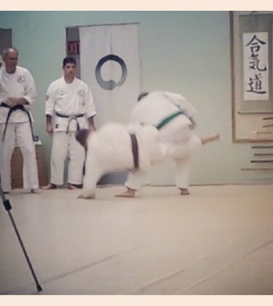

The BEST way to injure your Uke ~ demonstrated here: Perform a technique he has never been taught in a free flowing attack line. This is during my attack line for Sho-Dan.
I like the picture. I just wish the Uke had a purple belt on.


Uke’s fall looks worse than it actually is. This is an application I evolved over time. I use it regularly. It’s a cross between a Body Block, Pivot Over the Back, Back Breaker, with a little Muggers Throw thrown in for fun. While the fall is surprisingly easy, it’s still not a technique you want to bust out on someone with out confidence in their ukemi abilities. Before my attack line test, I did this technique on every attacker to make sure they were ready for it.

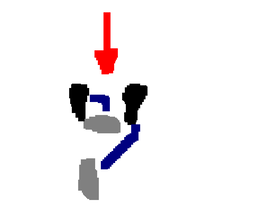
The Tenkan Movement into Hamni: A simple pivoting/ turning movement directly back and ever so slightly off line. It provides immediate flanking opportunities, and works especially well against committed straight attacks (like a 1 hand push).
The Tenkan Movement


2014 - 2021 ngaexperience.com
Unless otherwise stated, the author’s views, musings, and opinions do not necessarily reflect the attitude of leadership within any of the various Nihon Goshin Aikido associations, or unaffiliated Nihon Goshin Aikido dojos.

@ 1:00, you can see the application (depicted in the picture above) in full motion.

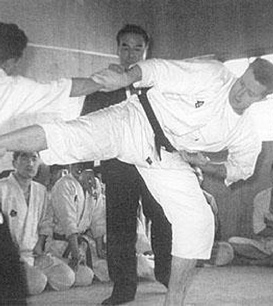

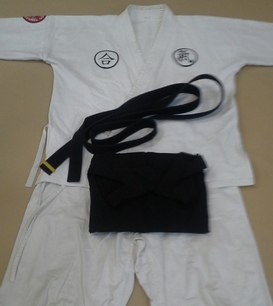

The Classic Lines of the Nihon Goshin Aikido training gi are unmistakable.
- White Gi
- “Ai” patch on the right breast
- “Ki” patch on the left breast
- Association patch on the right shoulder.
- Applicable belt (white, yellow, blue, green, purple, brown, black),
- Black hakama (worn only by those who have achieved a black belt in Nihon Goshin Aikido)
Some things simply never change. The student/ instructor uniform is one of those things. It marks a connection all the way back to the Chitose dojo, and should be preserved.

Seagal Knows The Scoop Against The Kick?
Click Here to Read Our Analysis of Taka Sensei (Steven Seagal’s) Aikido
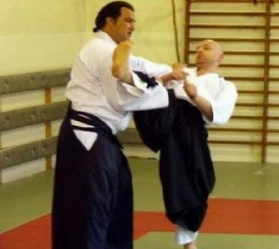
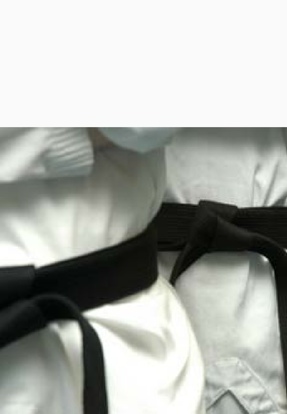

The best time to plant a tree was 20 years ago. The second best time to plant a tree is today.
Click here for a list of Nihon Goshin Aikido Dojos ~ and begin training with us today!


